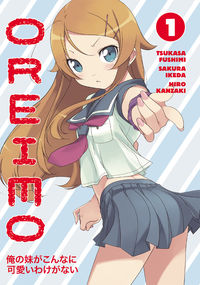 The Oreimo anime took me by surprise; that is a difficult thing to do, considering the many years I’ve been a fan of anime. It had many of the typical characters and themes I’d seen before—moe, otaku, eroge—but presented them atypically, giving them depth and drama, while maintaining a sense of humor. However, it was the inclusion of a not-too-subtle hint of a brother/sister complex that never quite allowed me to become too comfortable with the series, which only added to its appeal. It made me pay attention. As I made my way through the show, I discovered Oreimo wasn’t only humorous and pretty to look at; it was smart.
The Oreimo anime took me by surprise; that is a difficult thing to do, considering the many years I’ve been a fan of anime. It had many of the typical characters and themes I’d seen before—moe, otaku, eroge—but presented them atypically, giving them depth and drama, while maintaining a sense of humor. However, it was the inclusion of a not-too-subtle hint of a brother/sister complex that never quite allowed me to become too comfortable with the series, which only added to its appeal. It made me pay attention. As I made my way through the show, I discovered Oreimo wasn’t only humorous and pretty to look at; it was smart.
So when I learned that Dark Horse Comics licensed the Oreimo manga (Ore no imouto ga konnani kawaii wake ga nai [My little sister can’t be this cute]), I was immediately intrigued. First, as a manga fan, because I usually found that the manga of a series was able to flesh out its story more than its anime counterpart; and second, as someone familiar with the history of the company.
Dark Horse Comics has always lived up to its name, building a strong reputation over the years by releasing gritty, full-bodied comics, which were often considered outside of mainstream. The titles on their roster reflected the attitude of the company; they weren’t interested in being shallow. Therefore, any book that bore the Dark Horse Comics imprint had an air of substance to it. That didn’t change when it came to their manga selections. They licensed some of the most iconic titles in the history of manga in America. Ghost in the Shell, Old Boy, Gantz, Berserk, and Akira remain among the most popular, bold, and disturbing manga ever imported to the United States. It’s that daring decision making that has gained this company a place beside the mainstream, while still appealing to fans of the “underground.” That’s what makes Oreimo a perfect fit in the Dark Horse Comics stable.
I bought a copy of volume 1 as soon as I could. It swiftly became evident, as I read through the first few pages, that this manga was not a printed version of the animated series; its level on the “risk meter” was turned up much higher. Many of the scenes surprised and shocked me, once again leaving me a bit uncomfortable, yet still engaged. The story’s portrayal in the anime was clearly a lighter, “safer” adaptation.
After reading the first chapter (and recognizing that my face had been frozen in shock for most of that time), I turned to the front and back covers, looking for an age rating; there wasn’t one. The only “warning” that was present was the Dark Horse Manga imprint. After chuckling to myself, I nodded in silent agreement; that imprint was the only warning necessary. I turned the book over and started the next chapter. I am now eagerly awaiting the release of volume 2.
Ezra Desu
Guest Blooger